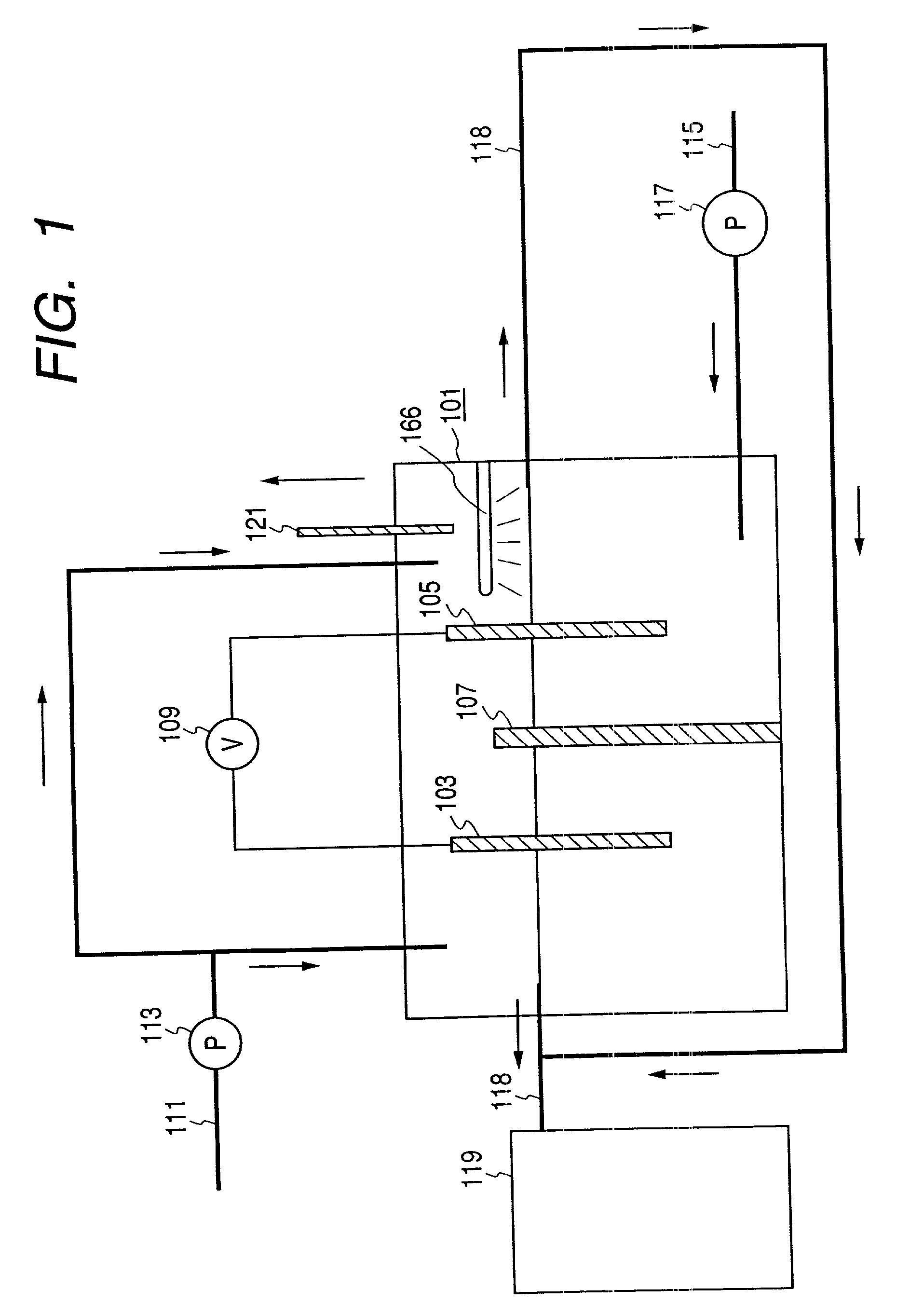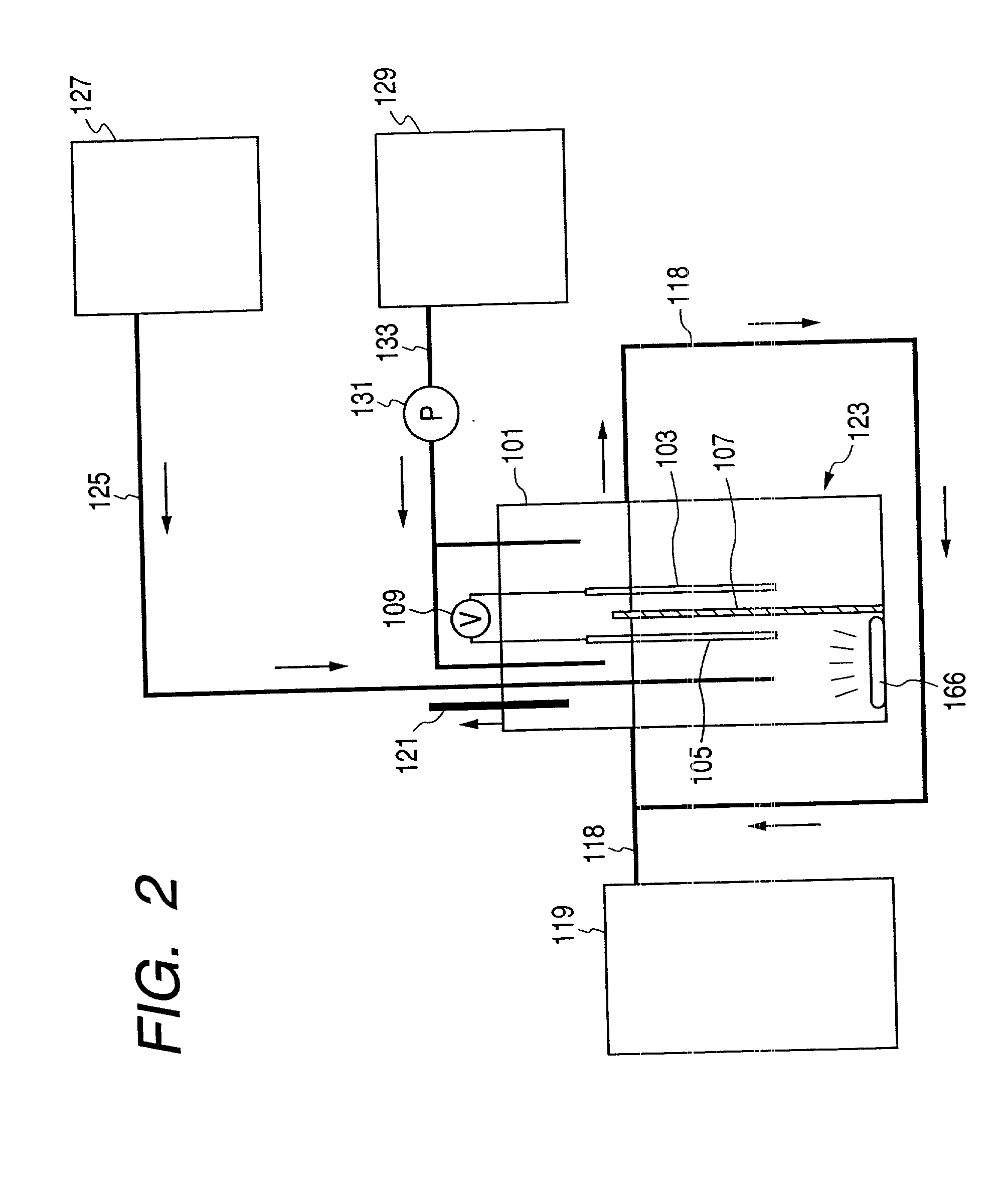Method of decomposing halogenated aliphatic hydrocarbon compounds or aromatic compounds and apparatus to be used for the same as well as method of clarifying exhaust gas and apparatus to be used for the same
a technology of aromatic compounds, which is applied in the field of decomposing halogenated aliphatic hydrocarbon compounds or aromatic compounds, can solve the problems of contaminating river water, ground water and soil of compounds already released into the natural environment, and achieving the effect of efficient decomposition, efficient purification and cleansing
- Summary
- Abstract
- Description
- Claims
- Application Information
AI Technical Summary
Benefits of technology
Problems solved by technology
Method used
Image
Examples
example 1
[0115] Decomposition of Trichloroethylene by Means of Functional Electrolytic Water and Light Irradiation
[0116] To begin with, functional water was prepared using a strongly acidic functional water generating apparatus (Strong Electrolytic Water Generator (Model FW-200): tradename, a product of Amano Co. Ltd.) having a diaphragm arranged between the anode and the cathode. Using this apparatus, water of various electrolyte concentrations and various electrolysis periods, acidic functional water was prepared at the anode side, of which pH value, of which oxidation-reduction potential were determined by means of a pH meter TCX-90i and KP900-2N (Tradename, a product of Toko Chemical Laboratories) and an electroconductivity meter TCX-90i and KM900-2N (Tradename, a product of Toko Chemical Laboratories) respectively, as well as the chlorine concentration of by a chlorine test paper (Advantec). As a result, the pH value varied between 1.0-4.0, oxidation-reduction potential of the functiona...
example 2
[0119] Decomposition of Trichloroethylene by Functional Electrolytic Water and Light Irradiation
[0120] Functional water was prepared as in Example 1. In this Example, function water having a pH value of 2.3, an oxidation-reduction potential of 1,050 mV and a residual chlorine concentration of 50 mg / l was prepared by electrolyzing water containing 1,000 mg / l of an electrolyte (sodium chloride) for 8 minutes.
[0121] Then, 50 ml of above functional water and then 100 ml of TCE-containing water (5 ppm) were put into a 200 ml vial, which was hermetically sealed with a teflon-lined butyl rubber cap and an, aluminum seal. After slowly agitating the content three to four times, the vial was left under direct sun light from noon for two hours. The intensity of irradiation was between 0.4 and 1.2 mW / cm.sup.2 when determined by a UV intensity integrating meter. Then, the gas phase in the vial was sampled by means of a gas-tight syringe and subjected to gas chromatography (GC-14B with an FID det...
example 3
[0122] Decomposition of Trichloroethylene by Functional Electrolytic Water and Light Irradiation
[0123] Functional water was prepared by using a strongly acidic electrolytic water generator (OASYS Bio HALF: tradename, a product of Asahi Glass Engineering). The functional water of this example had a pH value of 2.2, an oxidation-reduction potential of 1,000 mV and a residual chlorine concentration of 50 mg / l, obtained by electrolyzing water containing 1,000 mg / l of an electrolyte (sodium chloride). Then, a plurality of 27 ml vials were prepared, into which 10 ml of the functional water of 2-, 5-, 10- or 50-fold dilution was put. A vial containing pure water instead of functional water was also prepared as a control. The Each vial was hermetically sealed with a teflon-lined butyl rubber cap and an aluminum seal. Then, TCE gas was introduced into each vial through the butyl rubber cap by means of a gas tight syringe to a concentration of 10 ppm assuming that all TCE in the vial was comp...
PUM
| Property | Measurement | Unit |
|---|---|---|
| chlorine concentration | aaaaa | aaaaa |
| chlorine concentration | aaaaa | aaaaa |
| chlorine concentration | aaaaa | aaaaa |
Abstract
Description
Claims
Application Information
 Login to View More
Login to View More - R&D
- Intellectual Property
- Life Sciences
- Materials
- Tech Scout
- Unparalleled Data Quality
- Higher Quality Content
- 60% Fewer Hallucinations
Browse by: Latest US Patents, China's latest patents, Technical Efficacy Thesaurus, Application Domain, Technology Topic, Popular Technical Reports.
© 2025 PatSnap. All rights reserved.Legal|Privacy policy|Modern Slavery Act Transparency Statement|Sitemap|About US| Contact US: help@patsnap.com



